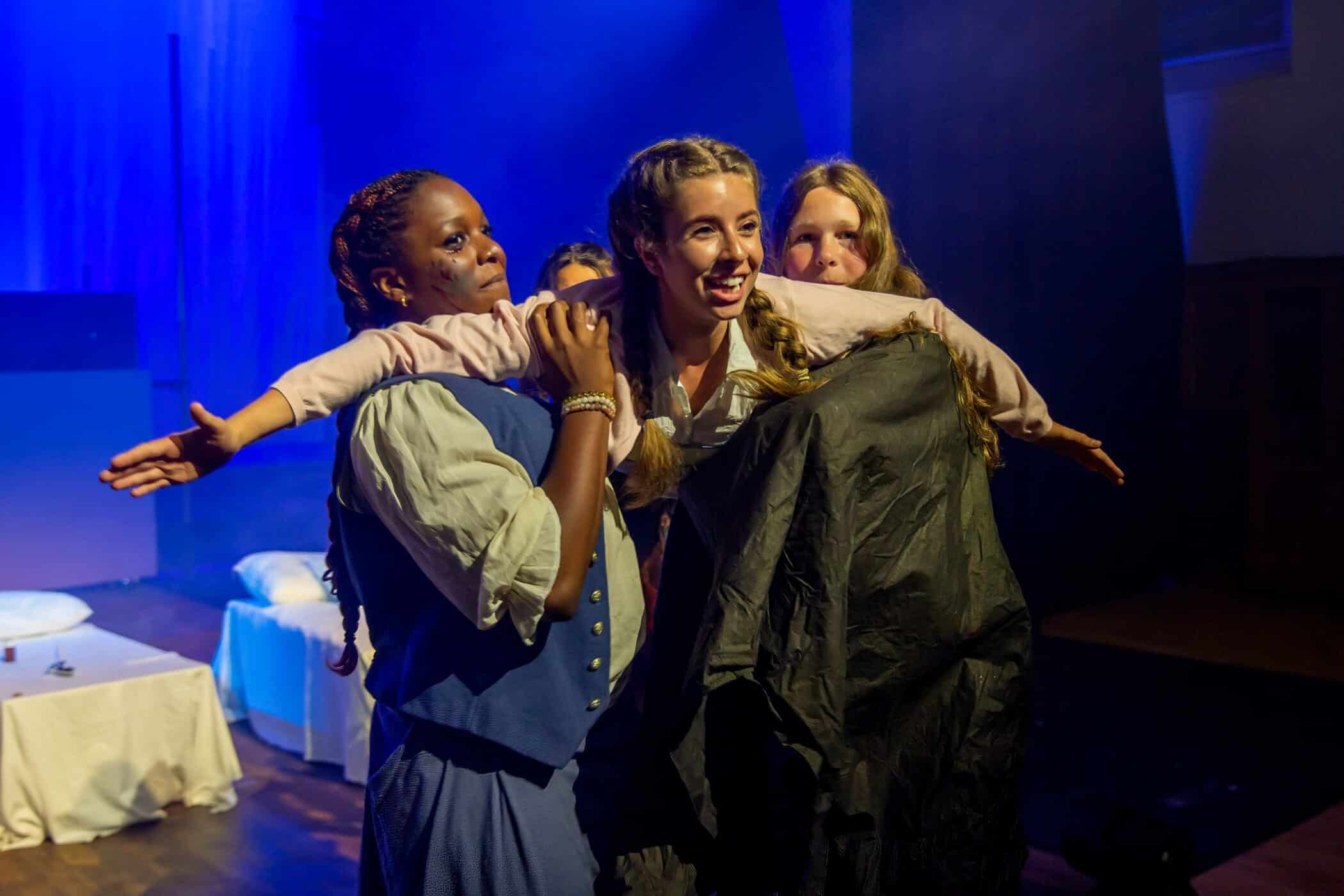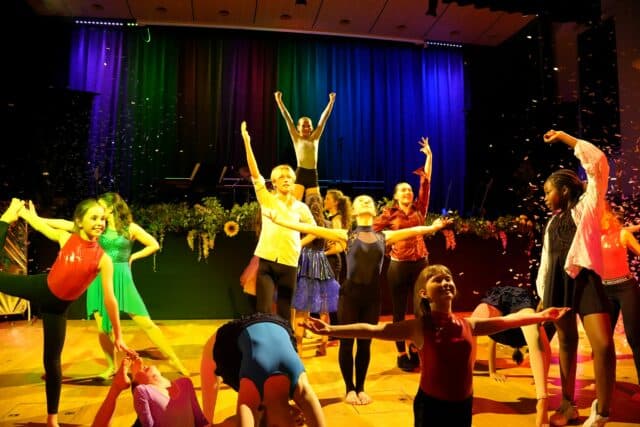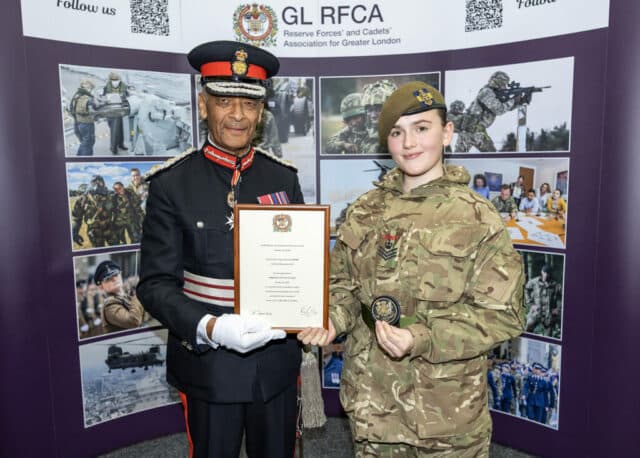The academic year is punctuated by many uplifting theatrical events, and this always includes the highly-anticipated Middle Fourth (Year 9) play. Not only do we meet the dramatic movers and shakers on the ascendency, but it is also a celebration of the year group as they begin the next part of their journey through the College.
Therefore, Wendy & Peter Pan was the perfect choice of play. It mirrors the Middle Fourth journey and captures the spirit of changing times. The play was developed for today’s audiences and is led from a female perspective, allowing for greater character development. Our cast certainly capitalised on this.
The play begins – unexpectedly, darkly – with the death of Tom Darling, played very sensitively by Stein Mackintosh. The careful casting of all the Darling family by the director Damon Young was very successful. George Stueck as John, and Rafael Menassa as Michael, portrayed their individual character traits very keenly and confidently. Gabriel Nel took on Mr Darling with gravitas and a wonderful sense of fun, and Sophia Traynor as Mrs Darling exuded motherhood with a good dose of force in the role.
Brooklyn Abt, as Wendy Darling, displayed superb confidence and gave a performance that showed a truly polished range of ability. She took the audience through Wendy’s struggle to find her place among the boys but also applied emotional sensitivity to the broader themes of childhood and growing up.
In parallel, Maxim Read, as Peter Pan, broke onto the stage with visceral physicality and the gift of truly being able to embody a character in totality. The audience saw the strengths and weaknesses of the character through Maxim as he hurled, twisted, and fought his way across the stage.
Three is the magic number
One of the inspiring aspects of this play was the sophisticated way that duos and trios worked together. Brooklyn and Maxim led this collaborative work assuredly, giving security to the play and enabling the actors to explore their characters and find depth within them. It enriched the production and allowed the audience a window into a familiar story from a different perspective.
Another hugely successful pairing was Lucy Peer as Captain Hook and William Watkinson as Smee. Lucy’s interpretation of Hook was utterly commanding, and the audience could not fail to see a character without redemption. She played Hook with a superb grip, never falling into pantomime cliche. She retained Hook’s sinister side to significant effect. In response, William played Smee as a character pushed to the limit of his nerves as he veered from fear to relief multiple times within a scene. William also effectively retained Smee as a person and not a caricature.
Two breakthrough performances came from Siena Plant as Tink and Lila Pramoj as Tiger Lily. Our collective memories know them as mild and benign characters. But in this version, they are far from it. Siena brought immense talent to play Tink as cantankerous, bolshy and downright stroppy. Her mischievous personality is littered with destructive tendencies and Siena grabbed the character by the wings and made her into her own; achieved by a great depth of character understanding.
Equally, Lila took Tiger Lily from the traditional meek and mild to an absolute warrior queen. Lila’s characterisation was superb; from stage fighting to eye-rolling, she visibly transformed on stage.
Importantly, when combined with Wendy, these three female characters form a triumvirate of femalehood that eventually sees them save the day. The audience felt this uplift as Brooklyn, Siena and Lila brought their characters together in an intense culmination.
Another successful triumvirate was formed between Tobi Akingbade as Slightly, Ivan Benham-Hermetz as Curly and Jack McAteer as Nibs, who offered great comic diversion, especially when meeting Wendy for the first time. Ned Frost was a lively and comic Tootles and together they made a suitably rag-tag group of Lost Boys.
Mimi Alalade-Blankson, Oscar Smith, Tilly Gale, Melissa Chee, and Lana Salami worked collectively as the Pirates with expressive performance; the eye twinkles, nods, and hand gestures embraced the stage and offered the audience a visual completeness to each scene.
Exemplary stagecraft
The cast had clearly worked hard on choreography, movement, and stage fighting. The fighting scenes were controlled and believable. The dancing and movement were both expertly performed with able talent and natural fluidity. This was exemplified by Satomi Brocklebank, Florence Williams, and Kirill Shashkov as the Crocodile and Peter’s Shadows. As the three expertly manoeuvred around the stage as one, the audience only needed to hear the steady “tick tock” to bring back childhood fears of the crocodile. Working in unison they created the illusion of Peter’s shadows to pronounced effect. It was a creatively unexpected yet triumphant depiction of both the Crocodile and the Shadows.
The set was imaginatively formed with fold-out flats against a box section that allowed for set changes and added height to the stage. A strong crew team of Elisa Chaplin, Ines Lonardo, Aditi Sharma and Qinan Yang were ably led by stage manager Yasmin Canty. The prop and set creation for the production was also aided by Maya Bristow, Catherine Anderson, Rebecca Jensen, Elyanna Oyediran and Imogen Stoles-Ollett. Working with our professional tech team, Ethan Catterall provided inspired music, lighting, and sound management that encapsulated the play’s spirit in its entirety.
This triumphant cast skilfully knitted the scenes together to deliver a meaningful collaborative experience. The transparency of emotional content that they offered was delivered with respect for the script but with a theatrical flourish that entertained and committed us to watch them with admiration and awe. For many, this is the start of their theatrical careers at the College, and we can only offer them hearty Fair Winds and Following Seas as they begin the next phase of their journey.





